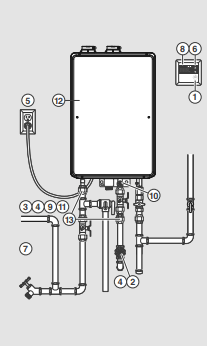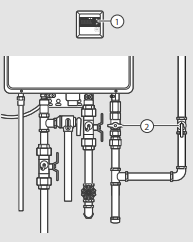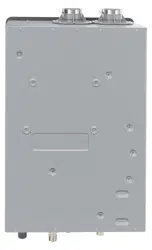Documents: Go to download!
User Manual
- User Manual - (English)
- Technical Specifications - (English)
- Spec Sheet (web) - (English)
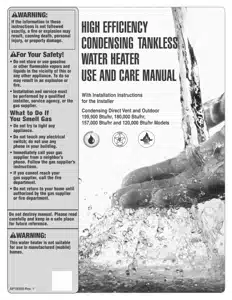
USE AND CARE MANUAL Water Heater
PRODUCT INFORMATION
Specifications – Direct-Vent Models
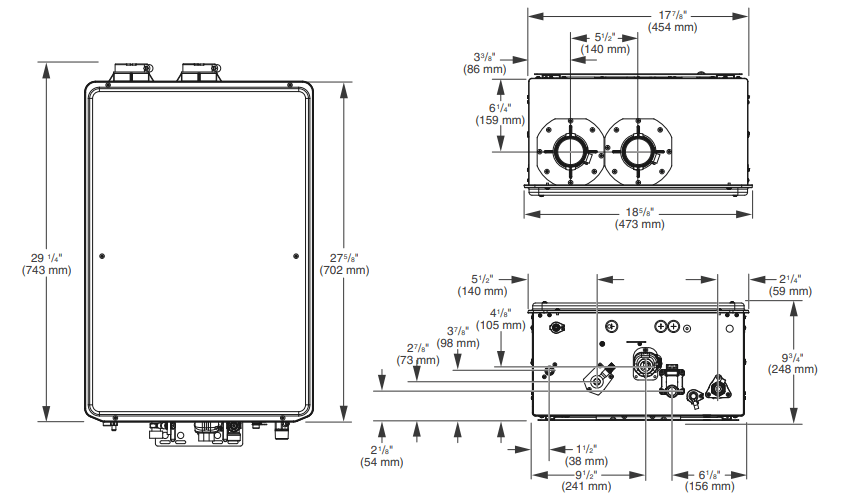
Specifications – Outdoor Models
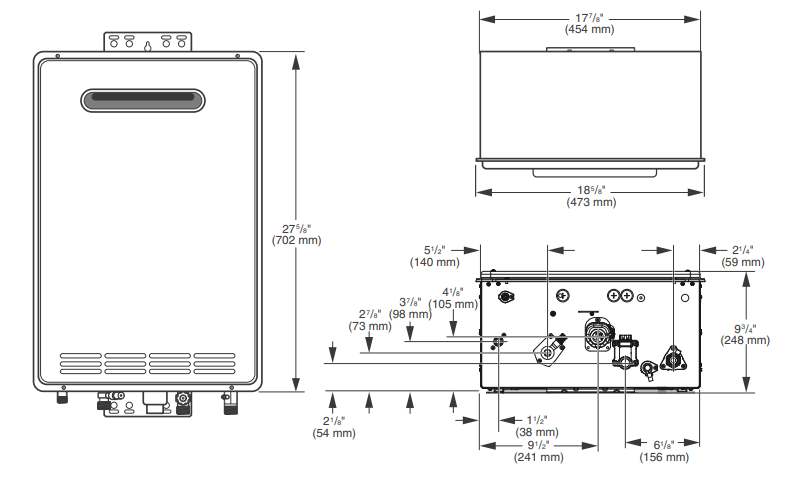
Specifications

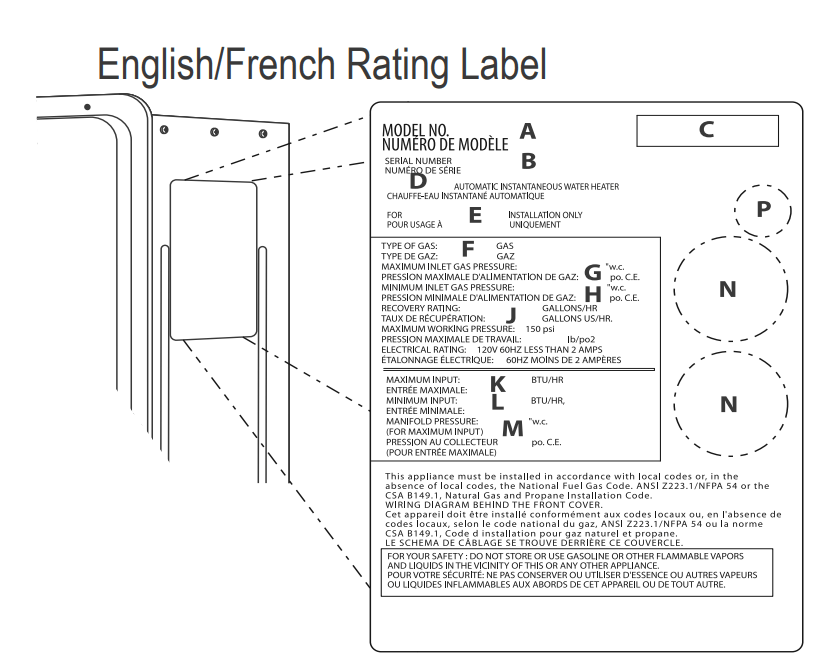

General Descriptions
Typical Direct-Vent Water Heater (Shown Without Venting)
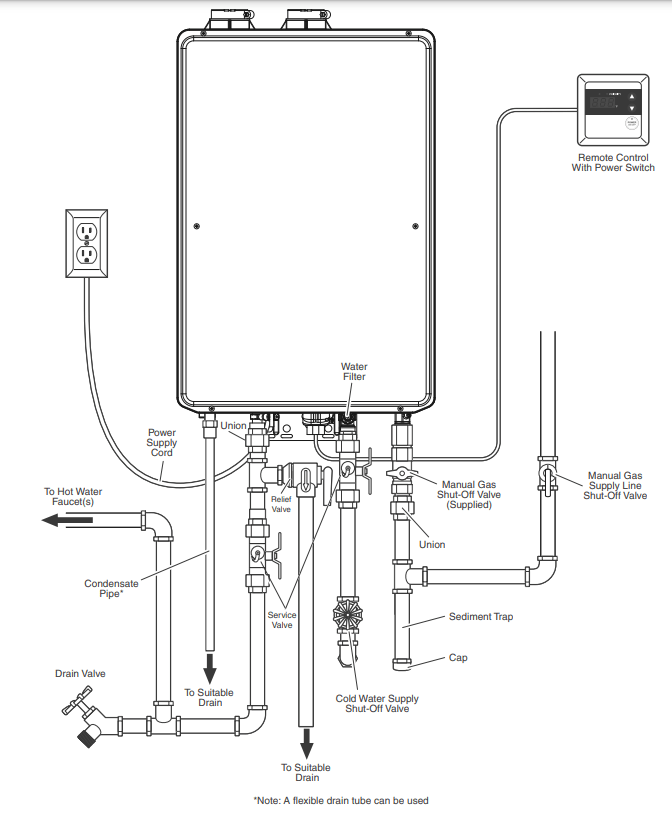
Typical Outdoor Water Heater (No Venting Required)
This water heater is for OUTDOOR installation only.
DANGER: DO NOT install this water heater indoors or in a confined space. It is designed for outdoor installation only. Any other type of installation will result in death or serious personal injury.
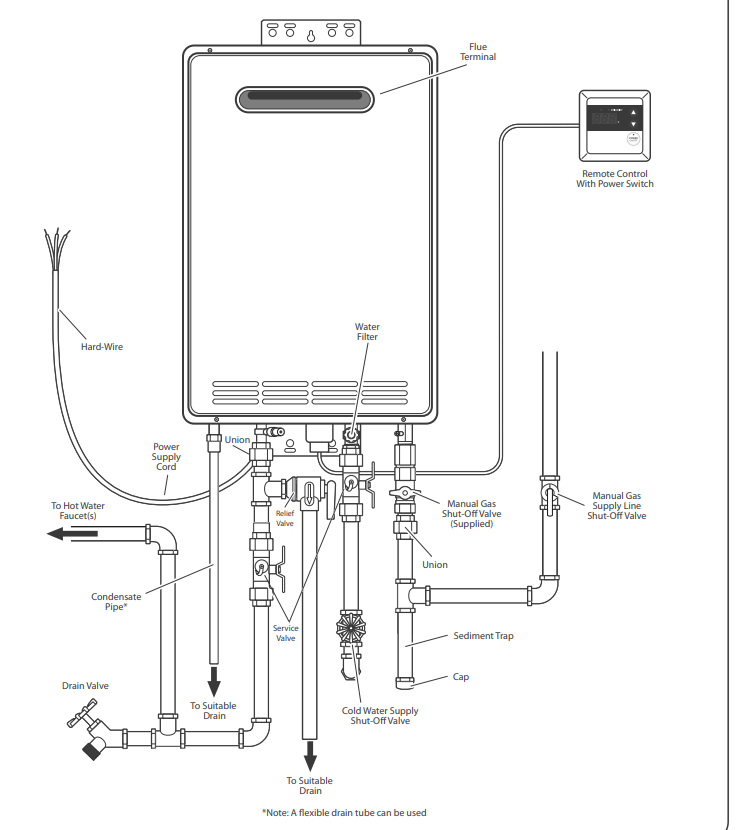
USING YOUR WATER HEATER
Safety Precautions
- Flammable vapors can be drawn by air currents from surrounding areas to the water heater. Vapors can ignite causing death, personal injury, or product damage.
- DO NOT store or use flammable or combustible materials (gasoline, paint thinner, adhesives, solvents, newspapers, rags, mops, etc.) in the vicinity of the water heater or any other gas appliance. If they must be used, open doors and windows for ventilation, and shut off all gasburning appliances, including their pilot lights.
- DO turn off manual gas shut-off valve if water heater has been subjected to overheating, fire, flood, physical damage, or if the gas supply fails to shut off.
- DO NOT turn on water heater unless water and gas supplies are completely opened.
- DO NOT turn on water heater if cold water supply shut-off valve is closed.
- If there is any difficulty in understanding or following the operating and care instructions in this manual, it is recommended that you contact a qualified service technician to perform the work.
Setting the Water Temperature
- DANGER: Water temperatures above 125°F (52°C) will result in death and/or severe burns from scalding.
- Safety and energy conservation are factors to be considered when selecting the water temperature setting. The temperature of the water in the water heater can be regulated by setting the temperature on the front of the remote control. Be sure to read and follow the warnings outlined on the pictured label.
- The recommended setting for the water temperature is 100°F (38°C). The remote control has been preset and shipped at the recommended temperature setting.
- Safety factors should be considered whenever altering the water temperature setting. The chart below may be used as a guide in determining the proper water temperature for your home.
Time/Temperature Relationship in Scalds
| Water Temperature | Time to Produce a Serious Burn |
| 120°F (49°C) | More than 5 minutes |
| 125°F (52°C) | 1 1/2 to 2 minutes |
| 130°F (54°C) | About 30 seconds |
| 135°F (57°C) | About 10 seconds |
| 140°F (60°C) | Less than 5 seconds |
| 145°F (63°C) | Less than 3 seconds |
| 150°F (66°C) | About 1 1/2 seconds |
| 155°F (68°C) | About 1 second |
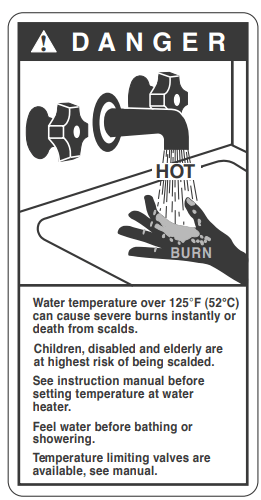
- Maximum water temperature occurs while the water heater burner is ON.
- To determine the water temperature: Turn on the hot water faucet and place a thermometer in the water stream.

- NOTICE: Water temperature at the faucet may vary depending on the season and the length of pipe from the water heater.
- The remote control temperature range is between 100°F (38°C) and 120°F (49°C). To adjust the temperature to a desired setting, press the UP or DOWN adjustment button on the face of the remote control. The new temperature set point will show on the LED display.
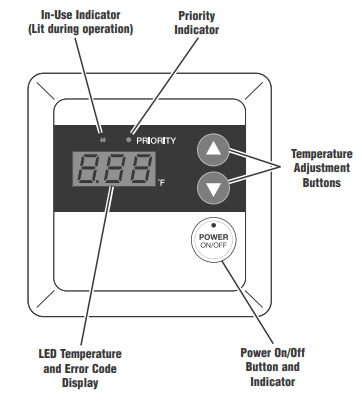
NOTICE:
- The temperature set point on the standard remote control cannot be increased above 112°F (44°C) when a hot water faucet is in the open position. To achieve temperatures above 120°F (49°C) or 85°F (29°C), contact a qualified service technician. Only factory-authorized remote control(s) should be used.
- The water heater may not operate with a small water flow. Increase the water flow and recheck. If it still does not operate with the hot water faucet completely open, increase the temperature setting on the remote control.
Water Heater Facts
DANGER: Water temperatures above 125°F (52°C) will result in death and/or severe burns from scalding.
- The hottest temperature water will be at the faucet closest to the water heater.
- Always remember to test the water temperature with your hand before use.
- Always supervise young children or others who are incapacitated.
- The water heater is equipped with a device that will shut off the gas supply to the burner if the water heater exceeds normal operating temperatures.
- Any water heater that has been subjected to fire, flood, physical damage, or been under water should be turned off at the manual gas shut-off valve and not used until it has been checked by qualified service personnel.
CARING FOR YOUR WATER HEATER
Water Heater Inspections
Venting System (Direct Vent Only)
- The venting system should be inspected annually to ensure all of the vent sections are secure and airtight. Qualified service personnel are familiar with vent system inspections and may be contacted for advice.
- WARNING: DO NOT operate the water heater if the vent system shows signs of leaking exhaust. Leaking exhaust could lead to death, personal injury, and/or product failure.
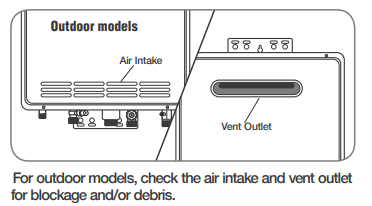
- DANGER: Shock Hazard – Make sure the electrical power to the water heater is OFF before removing protective cover. Electric shock will cause death or serious personal injury
Condensate Collector
CAUTIONS:
- Condensate is known to be acidic; refer to federal, state (provincial), and local codes for proper handling and discharge methods.
- DO NOT operate without the condensate collector drain connected and routed to a proper drain that can handle corrosive condensate. This could cause the system to malfunction or fail.
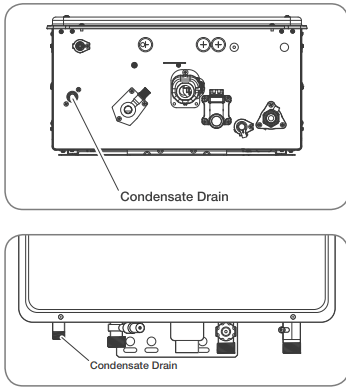
- On a regular basis, inspect the condensate drain line to ensure the condensate is draining properly.
- The condensate coming from the water heater is known to be acidic. The heater features a built-in condensate neutralizer that uses CaCO3 (calcium carbonate) in rock form as a medium.
- Periodically check the medium visually to ensure that it is not depleted and refill accordingly. It is recommended that you contact a qualified service technician to perform the work
Burner
- It is recommended the burner be annually inspected by a qualified service technician.
- DANGER: Shock Hazard – Removing the front cover panel exposes you to live electricity. Electric shock will cause death or serious personal injury.
1. Remove 6 screws and the unit cover panel.

2. Turn on a hot water faucet.
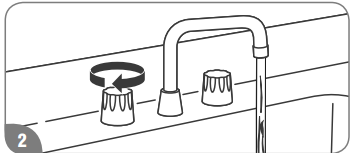
3. While the water heater is operating, inspect the main burner flames through the burner sight glass. The flames should be blue when the main burner is firing.
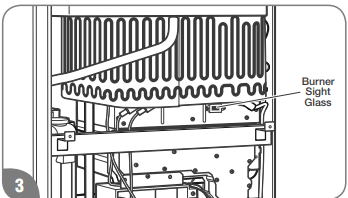
4. Turn off the hot water faucet and reinstall the unit cover panel.
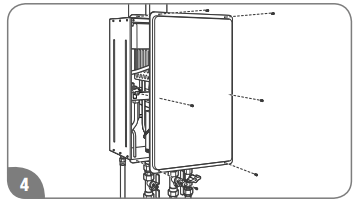
Care and Cleaning
- DANGER: Shock Hazard – Make certain power to the water heater is OFF before removing protective cover for any reason. Electric shock will cause death or serious personal injury.
- WARNING: Combustible materials, such as clothing, cleaning materials, or flammable liquids, must not be placed against or next to the water heater. Fire or explosion can occur causing death, personal injury, and/or product damage
- . All care and cleaning to and around the water heater should only be performed with the water heater turned off and the electrical power supply disconnected.

- NOTICE: The air intake requires a minimum of 12 in. (30 cm) of clearance between the air intake opening and any obstruction.
- Clean the water filter monthly, as described below and on the next page.
Water Filter Cleaning

CAUTION: DO NOT tap or force the filter during removal. This can deform and/or damage the filter.
CAUTION: DO NOT overtighten the water filter. Overtightening can deform and/or damage the filter.
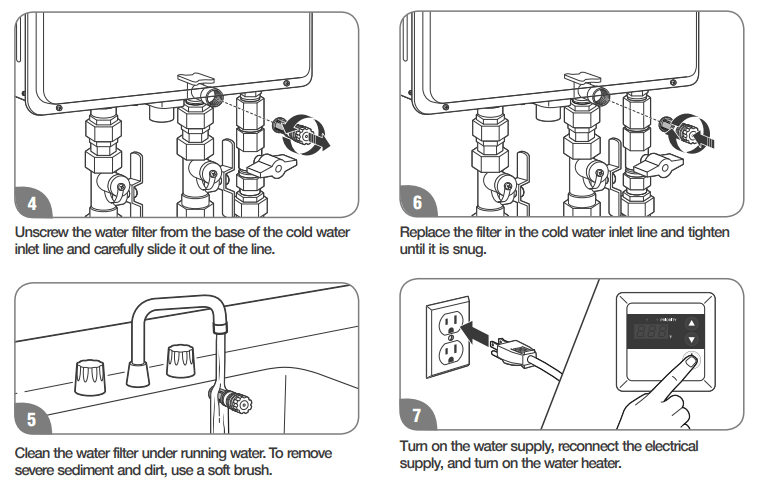
Preventive Maintenance
WARNING: Failure to perform routine preventive maintenance can prevent the water heater from operating properly. Improper operation can cause carbon monoxide dangers, excessive water temperatures, and other potentially hazardous conditions resulting in death, personal injury, and/or product damage.
Properly maintaining your water heater will ensure dependable, trouble-free service
User Preventive Maintenance
- Establish and follow a routine preventive maintenance program. The following suggested items should be included in your program.
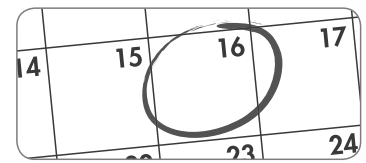
- Check and clean the water filter monthly. See “Water Filter Cleaning” on this Use and Care Manual.
- WARNING: Hot water is released during manual operation of the relief valve. Make sure all people and animals are clear from the area before performing this check to prevent death, personal injury, and/or property damage from hot drain water.
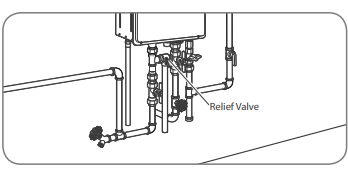
- Annually check the operation of the pressure relief valve annually. Lifting the lever handle on the pressure-relief valve opens the valve to flush hot water through the discharge line to the drain. After several gallons have drained, release the lever handle to close the valve and stop draining
NOTICE: If the pressure relief valve on the hot water heater discharges periodically, this may indicate a problem in the water system. Contact the water supplier or a plumbing contractor to correct the problem. DO NOT plug the relief valve outlet.
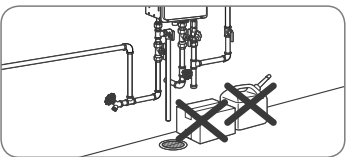
- • Inspect and keep the area around the water heater clear and free of flammable materials, such as gasoline and other flammable vapors and liquids.
- Visually inspect the water heater for damage and/or denting. If present, contact a service personnel to verify proper operation.
- Check for abnormal sound during normal operation (e.g., hissing or banging noises). Contact a qualified service technician or plumbing contractor if abnormal sounds are noted.
- Check all gas and water pipes for leaks. See "Leak Testing " on this Use and Care Manual
NOTICE:
- DO NOT operate the water heater if you feel something is wrong with the unit.
- DO NOT allow children to operate or handle the unit.
After inspections, maintenance, and/or cleaning, ensure proper operation by turning on a hot water faucet.
Professional Preventive Maintenance
- It is recommended that a periodic inspection of the water heater burner, relief valve, air intake filter, water filter, and venting system be made by a qualified service technician.
- WARNING: Certain water conditions can damage the water heater and may cause defects, malfunctions or failures of the water heater that are not covered by the limited warranty. See "Water Quality" on this Use and Care Manual.
Draining the Water Heater
WARNING: Failure to follow these draining instructions can cause serious personal injury from scalding and/or product damage.
- Turn off the water heater by pressing the POWER ON/ OFF button on the remote control.

- Close the gas shut-off valve(s)
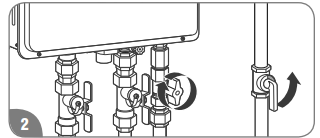
- At least 10 seconds after Step 1, unplug the water heater or disconnect the power supply at the circuit breaker box.
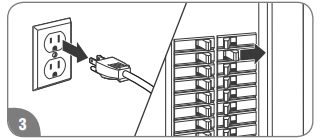
- Open all hot water faucets. Run the water until it is COLD; then shut off the faucet.
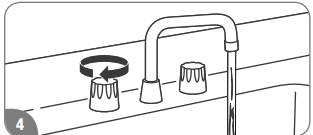
- Close the water shut-off valve.

- Find the water drain valve, the water filter and the water drain plug located at bottom of the water heater.
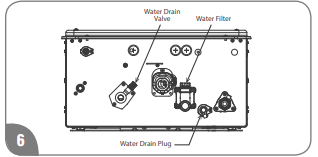
- Using a suitable container to catch the water, remove the water drain plug located at bottom of the water heater, the water drain valve from the base of the hot water outlet line, and the water filter from the base of the cold water inlet line.
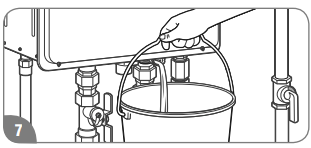
- Connect a garden hose to the drain valve in the hot water outlet line and place the other end in a suitable drain. Open the drain valve until all the water has drained from the water heater. Leave water heater as is until placed back in service

CAUTION: Even when drained properly, a small amount of water will remain in the water heater. In cold weather conditions, this water can freeze. If this happens, allow the defrost protection on the water heater at least 30 minutes to melt the frozen water. The water heater will not work properly until this water is thawed.
To put the water heater back in service:
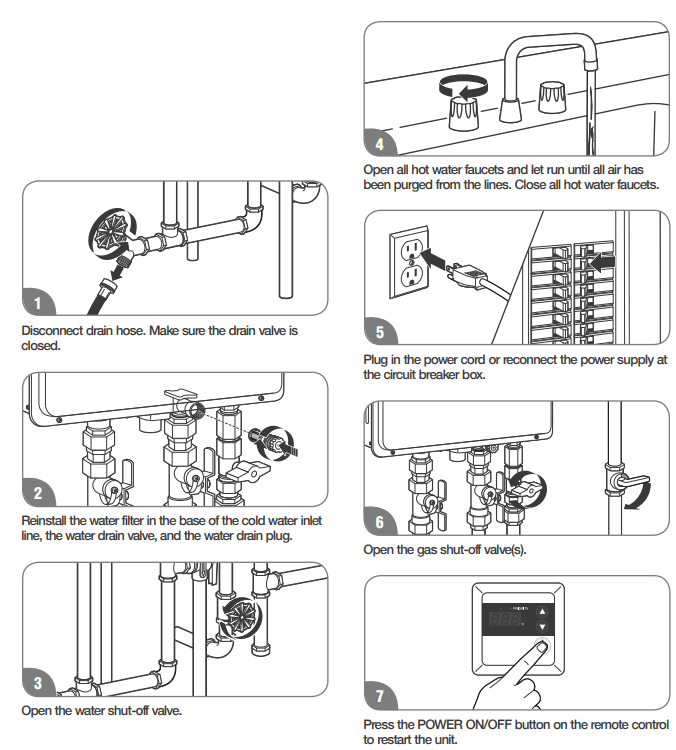
Standard Drain Method: Service isolator valve kits may be purchased from the manufacturer, distributor, or place of purchase. The kits include two full-port isolation valves to be used in the inlet and outlet water lines. These kits provide a means for full diagnostic testing and ease of system flushing and draining.
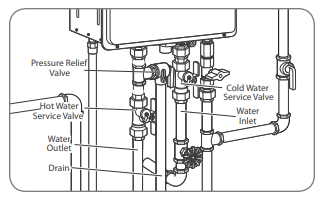
Freeze Protection
Running Water Freeze Protection
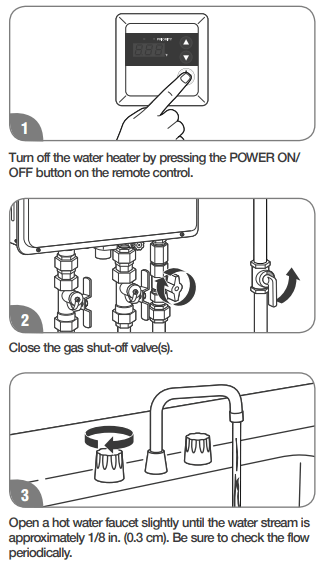
WARNING: Failure to drain the water heater can cause serious personal injury from scalding and/or product damage. Whenever the water heater may be exposed to freezing conditions, make sure to completely drain the water from the unit. See "Draining the Water Heater. Freezing conditions come from the ventilation system on direct-vent models and from exposure to cold air on outdoor models. All of these water heaters are equipped with a freeze protection electric heater. This heater prevents freezing inside the water heater down to an ambient temperature of approximately -22°F (-30°C). These temperatures are all based on temperatures without wind. The heater only protects the internal components of the water heater.
NOTICE: Unplugging or disconnecting the power supply to the water heater will also disconnect the power to the freeze protection electric heater. External piping and valves require additional freeze protection. One method is to wrap insulation around the piping and valves. Another method is to turn on a hot water faucet and leave a small amount of water running at a faucet. This will protect the water heater, piping, and valves from freezing.
Vacation and Extended Shutdown
- WARNING: Failure to drain the water heater can cause serious personal injury from scalding and/or product damage.
- If the water heater is to remain idle for an extended period of time, the power and water to the heater should be turned off.
- The water heater and piping should be drained if they might be subjected to freezing temperatures. See “Freeze Protection” section on this Use and Care Manual.
- After an extended shutdown, the water heater’s operation and controls should be checked by a qualified service technician.
Troubleshooting Chart
The information in the following troubleshooting chart may help you diagnose and/or fix a problem you may be experiencing. Please review this chart before calling for service assistance.
DANGER: Shock Hazard – Make certain power to the water heater is OFF before removing protective cover for any reason. Electric shock will cause death or serious personal injury.
WARNING: For Your Safety, DO NOT attempt repair of electrical wiring, gas piping remote control, burners, vent connectors, or other safety devices. Refer repairs to a qualified service technician.
| Problem | Possible Cause | Solution |
|
Not enough or no hot water.
|
1. Unit is not ON. 2. Water shut-off valve is not completely opened. 3. Hot water faucet is not completely opened. 4. Water piping is frozen 5. Electrical power is disconnected or water supply is shut off. 6. The temperature may be set too low 7. Mixing valve malfunctions (if applicable). 8. Error code displayed on the remote control. 9. Not enough water demand. 10. Water filter is clogged or dirty 11. Fixture aerator is clogged or dirty 12. Scale buildup in the heat exchanger. 13. Hot and cold water lines reversed. |
1. Turn on the unit by pressing the POWER ON/OFF button. 2. Check shut-off valve and open completely. 3. Open hot water faucet completely. (The main burner goes off when incoming water volume is inadequate.) 4. Allow piping to thaw. 5a. Plug in the power cord or reconnect the power supply at the circuit breaker box. 5b. Completely open the water supply valve. (Inadequate water volume will cause the main burner to turn off.) 6. Increase the temperature setting 7. Check and replace the mixing valve. 8. See “Service Error Code Chart” on page 26. If required, contact a qualified service technician 9. Increase the hot water flow at the faucet. 10. Clean the water filter. 11. Clean the aerator. 12. Check for error code. If required, contact a qualified service technician. 13. Reverse the water lines. |
|
Water not hot enough.
|
1. The temperature may be set too low. 2. The gas valve is not completely opened 3. Gas supply pressure is low 4. Bleed-over in one of the hot water fixtures.
|
1. Increase the temperature setting at the remote control. 2. Check and completely open the gas valve. 3. Contact your gas utility company or gas contractor to verify the gas meter and gas piping size. 4. Contact a dealer or a qualified service technician. |
|
Water too hot
|
1. Temperature is set too high. 2. Water shut-off valve is not completely opened. 3. Small amount of water has been heated. |
1. Decrease the temperature setting at the remote control. 2. Check and completely open the water shut-off valve. 3. Increase the hot water flow at the faucet to allow more water to flow through the water heater. |
| Fan continues to rotate after the hot water faucet is closed. | The post-purge cycle clears flue gases. | Normal operation. |
Service Error Code Chart
- Your water heater has an electronic diagnostic system built into it.
- When the water heater finds a problem, it displays an error code in the LED display on the remote control. The chart on the next page lists the error codes along with their possible problem and solution. Using this chart may help you diagnose and/or fix a problem you may be experiencing. Please refer to this chart before calling for service assistance.
- DANGER: Shock Hazard – Make certain power to the water heater is OFF before removing protective cover for any reason. Electric shock will cause death or serious personal injury.
- WARNING: For Your Safety, DO NOT attempt repair of electrical wiring, gas piping, remote control, burners, vent connectors, or other safety devices. Refer repairs to a qualified service technician. When an error code is displayed:
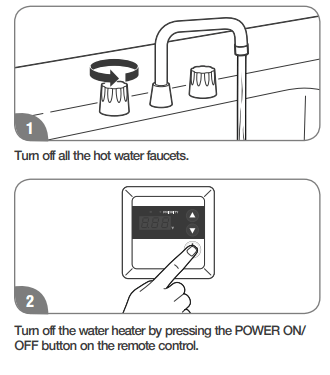
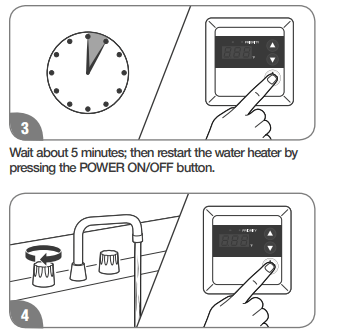
Turn on a hot water faucet and recheck the remote control display. If the error code remains in the display:
- Turn off the hot water faucet.
- Turn off the water heater.
- Unplug the water heater from power, wait about 30 seconds and plug back in.
- Follow the error code chart information.
- Restart the water heater, turn on a hot water faucet, and recheck the remote control display.
If the error code is still shown:
- Turn off the hot water faucet.
- Turn off the water heater.
- Make note of the displayed error code and call for service assistance. See “Call for Assistance” section on this Use and Care Manual.
NOTICE: If the displayed error code is not listed in the chart, immediately turn off the water heater and call for service assistance.
| Error Code | Possible Cause | Solution |
| 1L | Water heater has buildup of lime deposits. | Contact a dealer or qualified service technician. |
| 05 |
Air intake or vent exhaust opening may be blocked. The vent pipes on the vent termination may not be connected properly. |
Remove any blockage. (Air intake requires 12 in. [30 cm] of clearance.) Contact a dealer or qualified service technician. |
| 11 | The gas shut-off valve is not fully opened. | Check shut-off valve and open completely. |
| 12 |
Gas service has been interrupted LP gas is running low (LP models only) |
Contact your gas utility company. Refill or replace your LP gas container |
| 13 | If this code is still displayed after taking the numbered steps above. | Contact a dealer or qualified service technician. |
| 14 | Water heater is overheating. | Contact a dealer or qualified service technician. |
| 15 | The heat exchanger is too hot. | Check for blockage in the vent. Contact a dealer or qualified service technician. |
| 29 | Neutralizer is clogged | Contact a dealer or qualified service technician. |
| 31 | Faulty inlet thermistor. | Contact a dealer or qualified service technician. |
| 33 | Faulty outlet thermistor. | Contact a dealer or qualified service technician |
| 61 or 99 | Faulty blower motor. | Contact a dealer or qualified service technician |
| 65 | Faulty water flow solenoid. | Contact a dealer or qualified service technician. |
| 92 | The neutralizer needs to be replaced soon. | The unit can be used for a while, but contact a dealer or qualified service technician. |
| 93 | The neutralizer must be replaced. | The unit cannot be used until the neutralizer is replaced. Contact a dealer or qualified service technician. |
| F1 | Not enough water flow to operate the unit. | Increase the water flow from the fixtures. |
| 88 | Reminder of flushing the heat exchanger and/ or replacing the water treatment filter. | Contact a dealer or qualified service technician. |
See other models: RMTG70DVLN-1 RMTG70DVLP-1 6G50PDV-65 12G40S-40E2 6G75PDV-75
